
Perceptions and definitions of masculinity vary from time to time and culture to culture. Throughout history, popular concepts of masculinity have been reflected in paintings and sculptures. Some are commissioned portraits, others are created from inspiration.
From Chinese scrolls depicting heavily costumed warriors to sculptures like Michelangelo's David, masculinity has often been seen in the guise of an athlete or soldier.
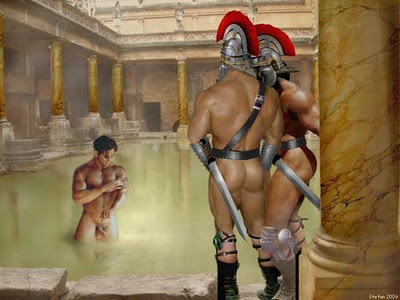
A classic piece of beefcake art by the French artist, Stefan
The ancient Greeks gave us heroes like Achilles and Odysseus. Following the invention of the printing press, novelists were able to create fictional heroes ranging from The Scarlet Pimpernel to Tevye and Tarzan; from Jean Valjean to Zorro and James Bond.
The advent of film and television went a long way toward shaping the public's visual perception of masculinity. From Rudolph Valentino to Ralph Kramden, from Robert Young's starring role in Father Knows Best to Hugh Jackman's characterization of Wolverine, men whose appearance spanned a wide range of virility, hirsutism, courage and sophistication have been celebrated.
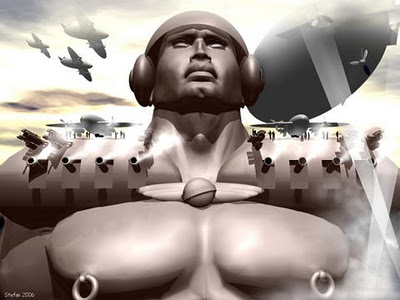
A militaristic image created by the French artist, Stefan
How men idealize other men has long been an inspiration for homoerotic art. The following image is a tame gateway to the intense work of Sadao Hasegawa, who was noted for his erotically-charged drawings of muscular Asian men in bondage.
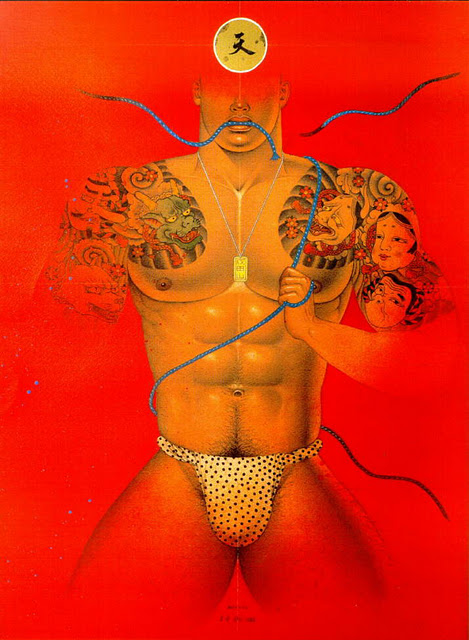
A drawing by graphic artist Sadao Hasegawa
Much the same could be said for Tom of Finland, whose aesthetic has long been the backbone of the leather subculture.
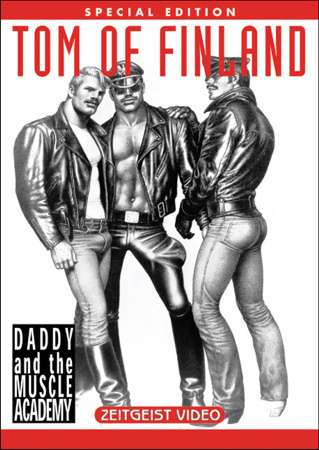
Cover art for Tom of Finland: Daddy and the Muscle Academy
Many men are drawn to bodybuilding as a way to combat their low self-esteem. For years, Charles Atlas marketed his products to teenagers who felt like the stereotypical "98-pound weakling."
As bodybuilding became perceived as more of a sport (and, to some, an art form), it triggered new levels of fascination. The growing popularity of bodybuilding magazines, musclebound superheroes in comic books, the sexual revolution, anabolic steroids and other "diet supplements" -- combined with images from films like 1976's Rocky and 1977's Pumping Iron -- helped to build a much larger audience for muscular men with pumped-up pecs, bulging biceps and chiseled abs.
As men's fashion advertising moved from the staid images seen in the Sears catalog to showing more skin and attitude, the concept of "manly men" split off in many directions. Some chose to adorn themselves with piercings and tattoos; others opted to express themselves through their wardrobe.
From Castro clones to big old bears, men seemed intent on celebrating the variety of body types. There were, of course, some notable exceptions.
* * * * * * * * * *
On November 27, 1929, just four weeks after the Wall Street stock market crashed, a new musical entitled Fifty Million Frenchmen opened on Broadway. The score by Cole Porter (which included "You Do Something To Me") inspired Irving Berlin to call it "the best musical comedy I have seen in years."
Libby Holman recorded one of the show's hit songs, "Find Me A Primitive Man," which is used as the background music for the following montage of clips from Johnny Weissmuller's old Tarzan movies.
Several months ago, while doing some research for my review of Lavinia Currier's new African adventure film (Oka!), I started to read about a movie she released in 1998 entitled Passion in the Desert. Based on a short story by Balzac, the action takes place in 1798, shortly after Napoleon began his invasion of Egypt.
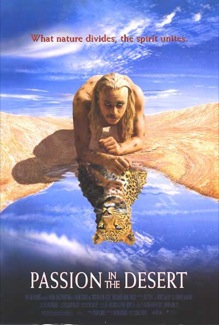
Poster art for Passion in the Desert
When I finally had a chance to rent Passion in the Desert from Netflix, I was bowled over by the experience. Aleksei Rodionov's gorgeous cinematography and José Nieto's original score provided a rare exotic foundation for one of the strangest love stories you'll ever see on film.
The story concerns a French soldier (Ben Daniels) who has been assigned to escort and protect an artist (Michel Piccoli) as he sketches famous Egyptian sculptures and monuments. The artist is an eccentric old coot.
After Mameluk tribesmen attack the French military encampment, the soldier and artist become separated from their comrades and wander alone in the Sahara. Augustin goes off in search of help and, left alone, the artist commits suicide by drinking his paints. Starved and nearing death, Augustin is miraculously saved by a leopard that attacks a Bedouin intent on killing the exhausted soldier.
Filmed on location in the ruins of Petra, Jordan and the caves of Moab, Utah, Passion in the Desert is a feast for the eyes. More interesting, however, is the transformation in Augustin's relationship with the leopard.
In order to stay alive, Augustin learns how to eat raw meat from the carrion of a freshly killed ibex and drink from a pool of water (just like a leopard does). As loneliness and the company of a big cat start to eat at his mental health, the soldier begins to fall in love with Simoom. Upon seeing Simoom playing with another leopard, he starts to become jealous.
Much of Passion in the Desert involves Augustin's slow but steady disintegration until he has reverted to a more primitive form of man. The following clip gives a solid feel for the movie's physical beauty -- as well as its raw honesty about the necessities of nature.
To read more of George Heymont go to My Cultural Landscape
